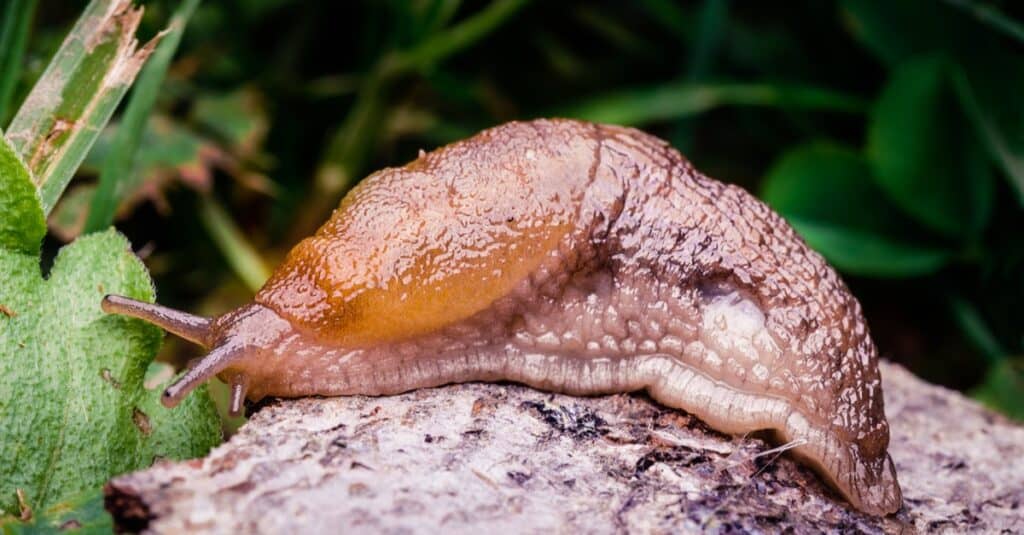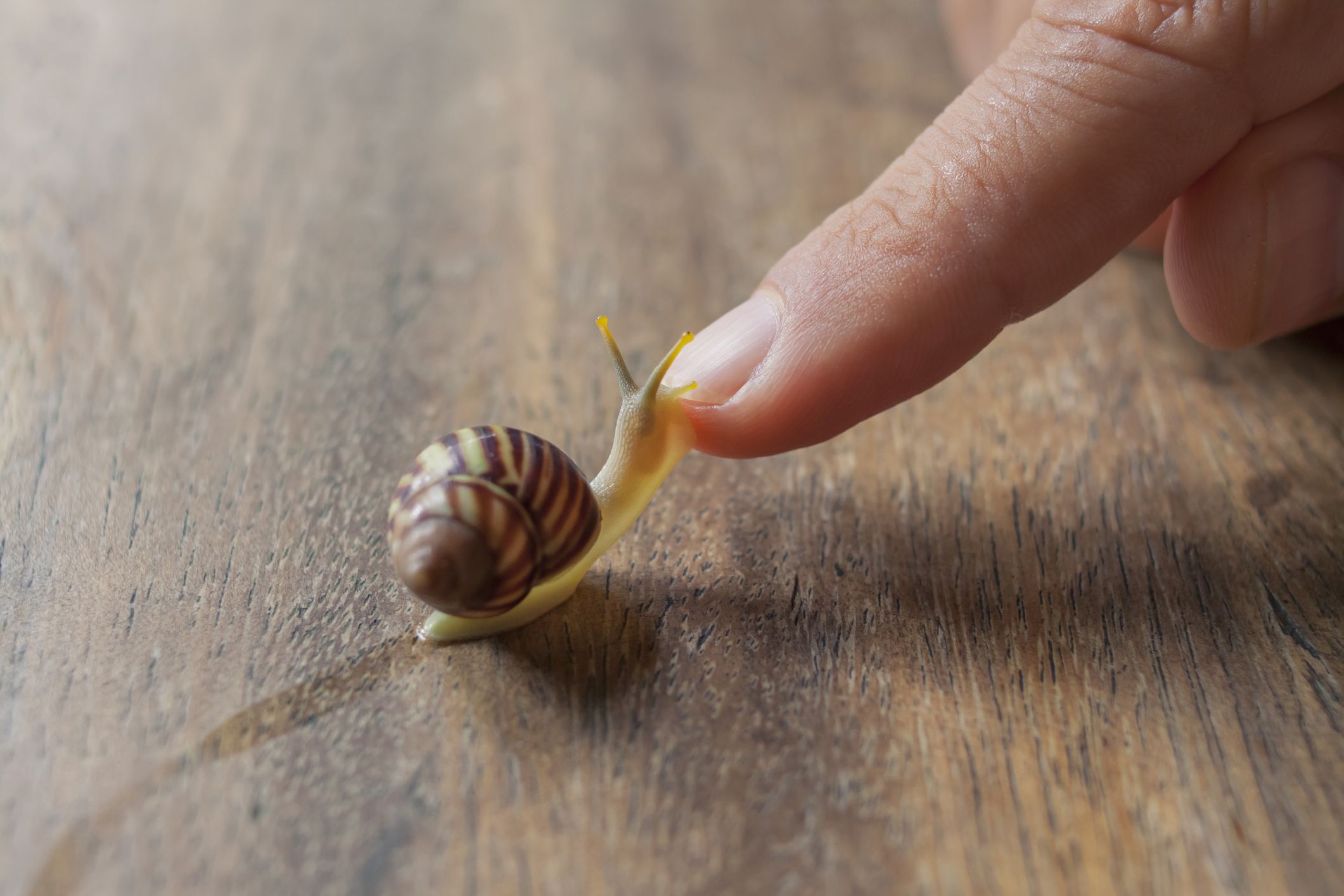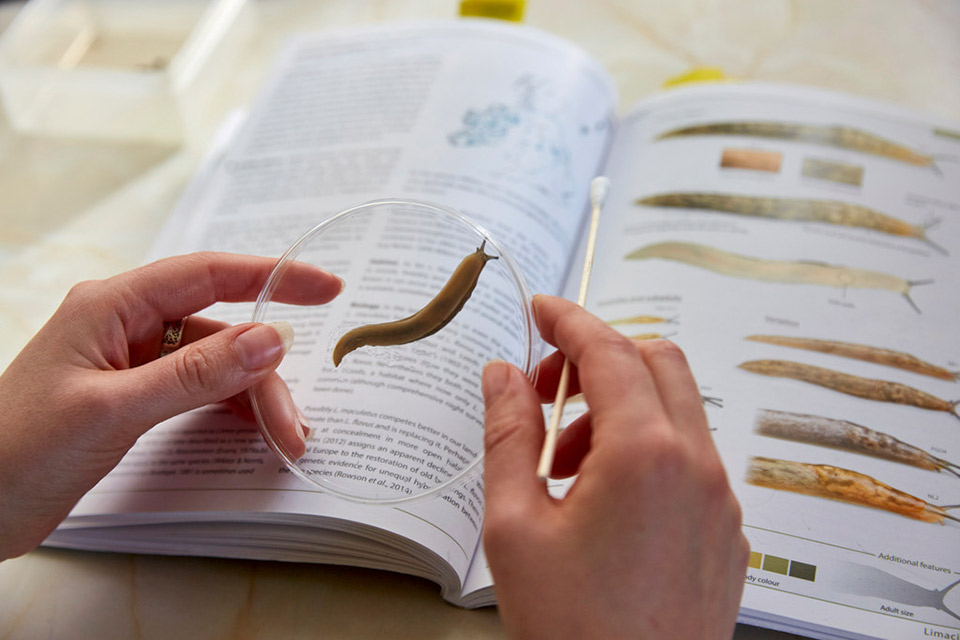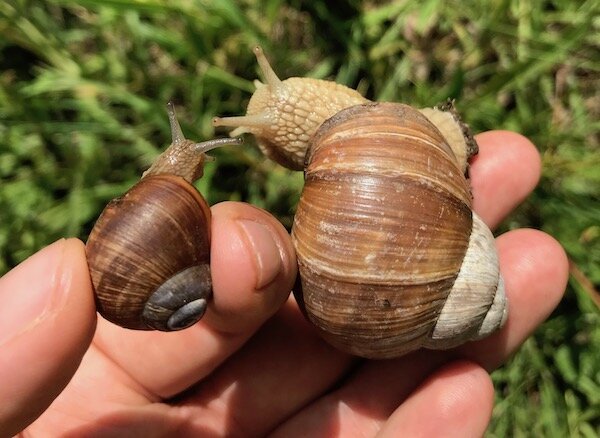Slugs and snails are similar in many ways but have some distinct differences. Both are mollusks from the class Gastropoda, thriving in moist environments. The most noticeable difference is their shell; snails carry a prominent, coiled shell on their back, which they retreat into for protection, while slugs lack a visible shell, making their bodies more exposed.
This lack of shell makes slugs more mobile and flexible, but also more vulnerable. Both creatures move slowly, gliding along on a muscular foot, leaving a trail of slime, which acts as a lubricant to reduce friction with the ground.
They are known for their appetite for plants, which can make them a nuisance in gardens. Despite these differences, both play a vital role in the ecosystem, contributing to nutrient cycles and serving as food for various predators.
What is Slug?
A slug is a common name for a gastropod mollusk without a shell or with a very small internal shell, in contrast to a snail which primarily has a prominent external shell.
Slugs belong to several different families that also include snails with shells. These creatures are notable for their elongated, soft bodies and their slow, gliding movement, facilitated by a muscular foot on their underside.

Slugs are found in a variety of environments, from forests to gardens, and are known for their voracious appetite for plants, making them a common pest in gardens and agricultural areas.
They breathe through an opening called a pneumostome, and like snails, they produce a slimy mucus that aids in locomotion and helps keep their soft bodies moist.
Slugs play an important ecological role, breaking down decomposing matter and contributing to the nutrient cycle. Their feeding habits can damage a wide range of living plants, leading to conflicts with humans in cultivated areas.
What is Snail?
A snail is a small, slow-moving mollusk with a distinct, coiled shell into which it can retract its soft body for protection. They are part of the class Gastropoda, which includes both terrestrial and aquatic species. Snails are found in a wide range of environments, from gardens and forests to rivers and oceans.

The shell of a snail, its most defining feature, is made primarily of calcium carbonate and grows as the snail grows. The shape and size of the shell vary widely among different species. Snails move by gliding along on their muscular foot, secreting mucus to help reduce friction with the surface.
Snails play a crucial role in the ecosystem. They are decomposers, feeding on a variety of materials including plants, rotting vegetation, and even animal matter in some cases.
Their diet makes them important for nutrient cycling in their environments. In gardens and agricultural areas, some species are considered pests due to their consumption of plants and crops.
In addition to their ecological role, snails have been used as a food source for humans in various cultures, known as escargot in French cuisine. Their shells have also been used for decorative purposes and as tools in various cultures throughout history.
Comparison table of Slug vs Snail
Here’s a comparison table highlighting the key differences and similarities between slugs and snails:
| Feature | Slug | Snail |
|---|---|---|
| Shell | Lacks an external shell. May have a small internal shell or none. | Has a prominent external shell for protection and retreat. |
| Habitat | Gardens, forests, damp areas. | Similar to slugs, including gardens, forests, and damp areas. Can also be found in freshwater and marine environments. |
| Movement | Moves using a muscular foot; secretes mucus for lubrication. | Similar to slugs, using a muscular foot with mucus secretion. |
| Body Structure | Soft, elongated body; more flexible due to lack of shell. | Soft body, but generally less exposed due to the presence of the shell. |
| Diet | Mostly plant materials, decomposing matter; can be a garden pest. | Similar to slugs, including plants and decomposing matter; some species also eat animal matter. |
| Ecological Role | Decomposers, nutrient cycling, and prey for various animals. | Similar to slugs; also contributes to soil aeration through burrowing. |
| Vulnerability | More vulnerable due to lack of shell. | Shell offers protection from predators and environmental elements. |
| Significance to Humans | Often considered pests in gardens and agriculture. | Similar to slugs, but also harvested for food (escargot) and decorative purposes. |
This table provides a general overview, there is a wide variety within both groups, and characteristics can vary significantly among different species within the slug and snail categories.
Importance of understanding their differences
Understanding the differences between slugs and snails is important for several reasons:
- Agricultural and Gardening Impact: Both slugs and snails can affect agriculture and gardening, but their impact and the methods used for management and control can differ. For example, certain control measures may be effective against snails but not slugs due to their lack of a shell.
- Biodiversity and Ecological Studies: For ecologists, distinguishing between slugs and snails is crucial for accurately assessing biodiversity. Each plays a unique role in the ecosystem, contributing to nutrient cycling, soil health, and the food chain.
- Pest Control Strategies: In pest management, knowing the specific habits and preferences of slugs versus snails aids in developing more effective control strategies. For instance, barriers that deter snails might not be as effective against slugs.
- Conservation Efforts: Some species of snails and slugs are endangered or have restricted habitats. Understanding their differences is vital for conservation strategies and to protect their natural habitats from human-induced changes.
- Scientific Research: For researchers studying gastropods, distinguishing between these two groups is essential for accurate data on behavior, physiology, and evolutionary biology. Different adaptations in slugs and snails can lead to varied research findings, particularly in areas like shell development and moisture retention strategies.
- Educational Purposes: Educating people, especially students, about the differences between slugs and snails can foster a better understanding and appreciation of biodiversity and the complexity of ecosystems.
- Culinary Uses: In some cultures, particularly in European cuisine, snails are a delicacy. Understanding the differences between snails and slugs is important for culinary purposes, as slugs are generally not consumed.
Recognizing the distinctions between slugs and snails enhances our ability to manage, study, and appreciate these creatures and their roles in various environments.
Physical Characteristics
The physical characteristics of slugs and snails are distinct in several ways, primarily due to the presence or absence of a shell. Here’s a detailed look at their physical characteristics:
Slugs
- Shell: Slugs are known for their lack of an external shell. Some species have a small internal shell or a reduced shell under their flesh, but it’s generally not visible.
- Body: They have a soft, elongated, and flexible body. This flexibility allows them to squeeze through very small spaces.
- Size: Slugs vary in size, ranging from a few millimeters to several inches in length, depending on the species.
- Color: Their color can vary widely, including brown, gray, yellow, green, or black, often with unique patterns.
- Mucus: They produce a significant amount of mucus, which is crucial for their mobility and helps to keep their body moist, which is essential for their respiratory function.
- Respiration: They breathe through a pneumostome (breathing hole), typically located on the side of their head or body.
Snails
- Shell: Snails are characterized by their prominent coiled shell. The shell is hard and protects from predators and environmental elements.
- Body: Beneath the shell, the snail’s body is soft and moist, with a muscular foot used for movement.
- Size: Like slugs, snail sizes vary widely. Some species are tiny, while others, like the Giant African Land Snail, can grow quite large.
- Color and Pattern: Their shells can exhibit a range of colors and patterns, which can be species-specific and sometimes quite intricate.
- Mucus: Snails also produce mucus, which aids in locomotion and moisture retention.
- Respiration: Terrestrial snails usually have a lung-like structure for breathing, while aquatic species have gills.
Both slugs and snails have similar sensory organs, like tentacles on their heads, with the upper pair bearing eyes at the tips, and a lower pair for tactile and olfactory senses.
They both have a similar diet, feeding mainly on plant material, but some species can be omnivorous. Despite their differences, slugs and snails share many characteristics typical of gastropods.
Diet and Eating Habits
The diet and eating habits of slugs and snails, while similar in many respects, also show some differences reflective of their ecological roles and adaptations.
Slugs
- Diet Composition: Slugs primarily feed on a wide variety of organic matter. This includes leaves, stems, flowers, fruits, mushrooms, and even decaying plant debris. Some species are known to eat other slugs or feed on animal waste.
- Feeding Behavior: Slugs have a rasping mouthpart called a radula, which they use to scrape or tear food. They often create irregular holes in leaves or fruits as they eat.
- Impact on Agriculture and Gardens: In gardens and agricultural settings, slugs can be significant pests. They are especially known for damaging leafy vegetables, seedlings, and ripe fruits.
- Nocturnal Feeding: Most slugs feed at night, which helps them avoid predators and reduces water loss in the daylight.
Snails
- Diet Composition: Snails also have a diet that consists largely of plant material – leaves, stems, fruit, and flowers. Some species are more specialized, feeding on algae, or are detritivores, consuming decaying organic matter. There are even a few carnivorous species.
- Feeding Behavior: Like slugs, snails use a radula to feed. Their feeding can be identified by the more uniform holes or scrapes on leaves and other plant parts.
- Impact on Agriculture and Gardens: Snails can be garden pests, similar to slugs, and are known to cause damage to a wide range of plants, particularly seedlings and tender foliage.
- Adaptations to Habitat: Some aquatic snails have adapted to scraping algae from surfaces, while others filter feed in the water.
Both slugs and snails are important for the ecosystem as they help in the decomposition process and nutrient cycling. Their eating habits, while sometimes problematic for human agriculture, are a natural part of the ecological balance, breaking down organic matter and serving as a food source for other animals.
Managing their populations in gardens and farms often requires an understanding of their specific dietary preferences and behaviors.
Cultural Significance
Slugs and snails, while often seen as simple garden creatures, have a notable cultural significance across different societies and historical periods.
Slugs
- Symbolism: Slugs generally lack the cultural prominence of snails, but in some cultures, they symbolize slow but steady progress, transformation, or resilience due to their ability to regenerate parts of their body.
- Folklore and Mythology: In certain folklore traditions, slugs have been seen as creatures of the night, often associated with dampness and decay.
- In Literature and Media: Slugs occasionally appear in literature and media, often characterized by their slow movement and slimy trail. They are sometimes used metaphorically to represent laziness or sluggishness.
- Scientific Interest: Slugs have drawn interest in biological and environmental sciences due to their adaptability and impact on ecosystems.
Snails
- Symbolism: Snails are often symbols of patience and slow but steady progress due to their slow movement. They also represent the protective shell that one retreats into, a metaphor for introspection or shyness.
- Historical and Cultural Significance: In ancient cultures, snail shells were used for various purposes, including as currency and decorative items. The spiral of the snail shell also holds mathematical and philosophical significance, often representing the concept of growth and evolution.
- Culinary Use: Snails are a delicacy in various cuisines, most notably in French cuisine (‘escargot’). This culinary tradition has a long history, dating back to ancient times.
- Art and Literature: Snails have been depicted in art, literature, and folklore for centuries. They often appear in children’s books and fairy tales, and their unique shape and slow movement make them a subject of fascination.
- Gardening and Agriculture: While often seen as pests in gardens and agriculture, snails also contribute to the narrative of human interaction with the natural world, particularly in discussions about biodiversity and ecological balance.
Both slugs and snails, through their unique characteristics and behaviors, have carved out a place in human culture and consciousness. They are not just simple garden animals but are creatures with a range of symbolic meanings and practical uses, reflecting the diverse ways in which humans interact with and interpret the natural world.
Slug and Snail Identification
Identifying slugs and snails is generally straightforward, especially considering the presence or absence of a shell. There are more nuanced features that can help in identification:
Slug Identification

- Absence of a Visible Shell: The most defining characteristic of a slug is the lack of an external shell. Some may have a small internal shell or remnants of a shell, but these are usually not visible externally.
- Body Shape and Texture: Slugs typically have elongated, slimy bodies. The texture can vary from smooth to granular or wrinkled.
- Color Variations: They come in a range of colors, including black, brown, gray, yellow, and even green or orange, sometimes with patterns or spots.
- Size: Their size can vary significantly, ranging from a few centimeters to up to 20 centimeters or more in some species.
- Tentacles: Look for two pairs of tentacles on the head; the upper pair has eye spots, while the lower pair is used for sensing smell and touch.
- Mucus Trail: A distinctive slime trail is often a giveaway of a slug’s presence, even if the slug itself isn’t visible.
Snail Identification

- Presence of a Shell: Snails are easily recognized by their coiled external shell. The shell size, shape, and color pattern can vary widely among species.
- Body Shape: When extended from their shell, snails have a soft, muscular foot, which is used for movement.
- Size and Shell Shape: Snail sizes range from tiny to very large, and their shells can be spiral, conical, or even flat in some species.
- Shell Colors and Patterns: Snail shells can have various colors and patterns, including single colors, bands, and speckles.
- Tentacles: Like slugs, snails have two pairs of tentacles. The upper pair typically has eye spots.
- Habitat Preference: Noticing where the creature is found can also aid in identification. Snails might be found in slightly drier locations than slugs, due to the protection their shell offers.
The habitat (like gardens, forests, under rocks, or near water sources) and the local geographical region can give clues to the specific species. For more precise identification, especially when distinguishing between similar species, consulting a field guide or a specialist can be helpful.
Similarities between Slug and Snail

Slugs and snails, despite their apparent differences, share several similarities due to their common classification within the Gastropoda class:
- Body Structure: Both have soft, unsegmented bodies with a muscular ‘foot’ used for movement.
- Mucus Production: They both produce mucus, which is essential for their mobility and helps to keep their bodies moist, a critical factor for their respiration.
- Respiration: Both slugs and snails breathe through a pneumostome, or breathing hole, although the specific mechanism can vary between aquatic and terrestrial species.
- Feeding Habits: They are predominantly herbivorous, feeding on a variety of plant matter, and using a radula (a tongue-like organ with tiny teeth) to eat.
- Habitat Preferences: Both prefer moist environments and are often found in similar habitats like gardens, forests, or near bodies of water.
- Reproduction: Many species of both slugs and snails are hermaphrodites, possessing both male and female reproductive organs.
- Sensory Organs: They have similar sensory structures, including tentacles on their heads, with eyes located on the tips of the longer pair in many species.
- Ecological Role: Slugs and snails play important roles in ecosystems, acting as decomposers and a food source for a variety of predators.
These similarities underscore their common evolutionary heritage and ecological functions, despite the obvious physical distinction of the snail’s shell.
Scientific Research
Scientific research on slugs and snails covers a wide range of topics, reflecting their ecological importance, unique biological features, and interaction with human activities. Here are some key areas of research:
Slugs
- Pest Control and Agriculture: Research often focuses on the impact of slugs on agriculture and gardening, developing environmentally friendly and effective pest control methods.
- Ecology and Biodiversity: Studies examine the role of slugs in ecosystems, their interactions with other species, and their responses to environmental changes.
- Physiology and Adaptation: Researchers investigate how slugs adapt to various habitats, their moisture retention strategies, and their remarkable ability to regenerate lost body parts.
- Behavioral Studies: Understanding the behavior of slugs, including feeding patterns, mating rituals, and movement, is a significant research area.
- Climate Change Impact: Investigating how changing climates affect slug populations and distributions, which in turn impacts ecosystems and agriculture.
Snails
- Biodiversity and Conservation: Research on snails often involves cataloging species, understanding their specific habitat requirements, and conservation efforts, especially for endangered species.
- Shell Development and Evolution: The development and variation in snail shells provide insights into evolutionary biology and the adaptation of species to different environments.
- Medical and Pharmaceutical Research: Certain snail venoms and secretions are studied for potential medical applications, including painkillers and treatments for various diseases.
- Aquatic Ecosystem Studies: For aquatic snails, research topics include water quality assessment, bioindicator roles, and the impact of invasive species on local ecosystems.
- Cultural and Archaeological Studies: Snail shells found in archaeological sites can offer insights into past climates, human diets, and trade practices.
Both slugs and snails are also used as model organisms in various scientific studies due to their relatively simple anatomy and ease of observation and experimentation. The research on these creatures not only contributes to our understanding of their species but also provides broader insights into ecology, evolution, and environmental science.
Which One Lives Longer – Snails or Slugs?
The lifespan of snails and slugs varies depending on the species and environmental conditions, but generally, snails tend to live longer than slugs.
- Snails: Many snail species have a longer lifespan, particularly due to the protection offered by their shells. On average, garden snails (like the common Helix aspersa) can live several years, with some species living up to 10 years or more under optimal conditions. The shell provides defense against predators and harsh environmental conditions, contributing to their longevity.
- Slugs: Slugs, lacking the protective shell, are more vulnerable to environmental hazards and predators. Consequently, they usually have a shorter lifespan compared to snails. Most common garden slug species live for about one to two years, although this can vary with the species and environment.
Slugs and snails can have their lifespans significantly affected by their habitat. Factors like climate, availability of food, presence of predators, and human activities (such as the use of pesticides) play a crucial role in determining their longevity.
In a controlled environment, like a laboratory or an enclosure, both slugs and snails can potentially live longer than in the wild.
Summary
Slugs and snails, while both belonging to the class Gastropoda, exhibit key differences. Slugs lack a visible shell, making them more vulnerable but also more mobile, while snails possess a protective external shell.
Both play crucial ecological roles as decomposers and are significant in agriculture as pests. Their distinct adaptations and behaviors reflect their unique evolutionary paths within the mollusk family.


